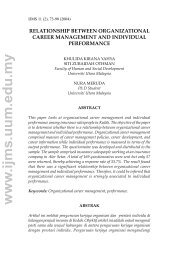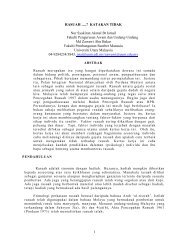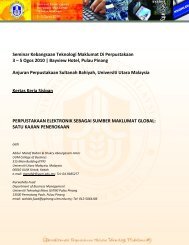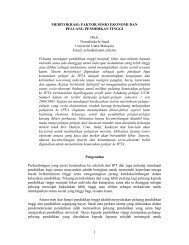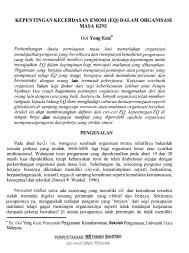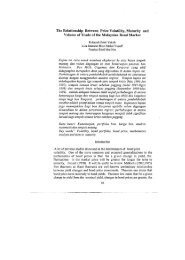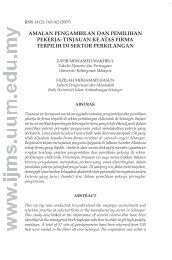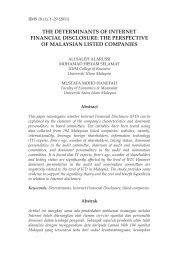The Development of ASEAN from Historical Approach
The Development of ASEAN from Historical Approach
The Development of ASEAN from Historical Approach
Create successful ePaper yourself
Turn your PDF publications into a flip-book with our unique Google optimized e-Paper software.
www.ccsenet.org/ass Asian Social Science Vol. 7, No. 7; July 2011<br />
forming security institutions that are done in the west. If this is carried out in a proper manner, CBM can be<br />
increase the peace and stability in this region (Jusuf Wanandi, 1996: xiii).<br />
4. <strong>ASEAN</strong>’s Political Cooperation<br />
4.1 <strong>ASEAN</strong> Regional Forum (ARF)<br />
<strong>The</strong> establishment <strong>of</strong> <strong>ASEAN</strong> Regional Forum (ARF) was suggested by Australia during the <strong>ASEAN</strong> Ministerial<br />
Meeting (AMM) in Jakarta, July 1990 (M. Antolik, 1994:118). <strong>ASEAN</strong> Regional Forum (ARF) was held for the<br />
first time on the 25th <strong>of</strong> July 1994 in Bangkok, Thailand (Micheal Liefer, 1996:22). ARF is <strong>ASEAN</strong>'s new idea<br />
<strong>from</strong> the fourth <strong>ASEAN</strong> summit meeting in the Declaration <strong>of</strong> Singapore 1992 (Zakaria Haji Ahmad, 1995:31). In<br />
this declaration, <strong>ASEAN</strong> seek to create <strong>ASEAN</strong> intensive dialogue with foreign countries especially the Asia<br />
Pacific in matters pertaining politics and security. Through this proposal, <strong>ASEAN</strong> can make ARF as the main<br />
medium to foster political and security relationship between <strong>ASEAN</strong> and Asia Pacific. ARF can even be the center<br />
stage to problem solving, dispute and security threat as well as nuclear threat among country members in a<br />
peaceful manner (Michael Leifer, 2001:61-63). <strong>The</strong> ability and effectiveness <strong>of</strong> ARF is clearly visible through<br />
efforts taken by member countries such as organizing regional security document, defence policy statement<br />
distribution between members, national policy and security aspect opinion, relinquishment <strong>of</strong> arms and defence<br />
activities such as signing UN’s comprehensive nuclear test ban treaty in 10 September 1995 (Mohd Rashid<br />
Darham, 1996:44). <strong>ASEAN</strong> Regional Forum (ARF) have 23 members. 10 countries are <strong>from</strong> <strong>ASEAN</strong>, they are:<br />
Brunei; Singapore; Thailand; Burma; Cambodia; Malaysia; Indonesia; Lao; Philippines and Vietnam. While 13<br />
other partners are European Union (EU), Australia, Canada, China, India, Japan, South Korea, North Korea, New<br />
Zealand, Russia, the United States, Papua New Guinea and Mongolia(Micheal Liefer, 1996:31). New country<br />
wishing to participate in ARF must be able to contribute and act collectively in any area especially to achieve the<br />
goal and objective <strong>of</strong> ARF. ARF's major challenge would be to to reinforce Asia Pacific security and maintain<br />
stability <strong>of</strong> regional politics. All country member should pay attention to related issue on security and political<br />
stability especially in the Asia Pacific region. During the ARF's conference on August 1995, it has been asserted<br />
the necessacity <strong>of</strong> member’s active involvement to ensure the goals and objectives <strong>of</strong> ARF are achieved.<br />
4.2 Declaration <strong>of</strong> <strong>ASEAN</strong> Concord<br />
This declaration orders each <strong>ASEAN</strong> country members to expand political cooperation among members and other<br />
countries outside <strong>ASEAN</strong>. This declaration also demands that <strong>ASEAN</strong> member countries resolve conflicts either<br />
with country members or non <strong>ASEAN</strong> country member through method <strong>of</strong> negotiation and peace. Each dispute<br />
and conflict must be resolved immediately to avoid the growth and persistent <strong>of</strong> the matter. This declaration also<br />
compels members to take every action collectively and stand for <strong>ASEAN</strong>'s basic principle.<br />
4.3 Southeast Asian Treaty <strong>of</strong> Amity and Cooperation (TAC)<br />
During the Bali conference 1967 the Southeast Asian Treaty <strong>of</strong> Amity and Cooperation (TAC) was sealed. This<br />
treaty is based on the non interventionpolicy principles <strong>of</strong> a country’ internal affairs, mutual respect <strong>of</strong> each<br />
country’s sovereignty and effective settlement <strong>of</strong> the intra region issues through peace and cooperation among<br />
country member. This agreement designed a peaceful settlement procedure code for each contention and mandated<br />
the establishment <strong>of</strong> a supreme council which comprises <strong>of</strong> Ministers <strong>of</strong> parties involved as a solving mechanism<br />
for conflict and dispute. To this date, TAC still remains the sole regional diplomatic tool providing mechanism and<br />
the proccess to solve regional conflicts peacefully. Kamboja's conflict is one <strong>of</strong> <strong>ASEAN</strong> diplomacy's success<br />
which was resolve peacefully. It is one <strong>of</strong> <strong>ASEAN</strong>'s methods which is known as the solution diplomacy or<br />
preventive diplomacy.<br />
4.4 Straits <strong>of</strong> Malacca Cooperation<br />
Existing problems in the straits <strong>of</strong> Melaka such as <strong>of</strong> pirates, border dispute, waters security, border invasion,<br />
sovereignty, illegal immigrants and illegal fishing have brought three <strong>ASEAN</strong> member countries to form a<br />
cooperation. <strong>The</strong> three countries are Malaysia, Singapore and Indonesia and have agreed to cooperation in<br />
ensuring security and resolving issues by applying cooperative patrol. This patrol called the Melaka Straits<br />
Singapore Coordinated Partol (MSSCP) is a combination <strong>of</strong> the three respective countries navy force since July<br />
2004 patroling 24 hours year round (Mohd. Fairuz Yus<strong>of</strong>, 2004). This cooperation is the evidence that the three<br />
countries have effective diplomatic ties and uphold <strong>ASEAN</strong>'s principle to act collectively in ensuring the security<br />
<strong>of</strong> straits <strong>of</strong> Malacca is under control (Mohd Fairuz Yus<strong>of</strong>, 2004). This agreement involved Malaysia’s military<br />
commander, Tan Sri Mohamad Zahidi Zainuddin and Royal Navy Admiral (RMN) Admiral Dato Seri Mohd.<br />
Mohd Anwar. Nor, Indonesia’s National Army (TNI) General Endriantono Sutarto and Navy Commander<br />
Admiral Bernard Kent Sondakh, while Singapore was represented by Singapore’s Military Commander (RSAF)<br />
176<br />
ISSN 1911-2017 E-ISSN 1911-2025




